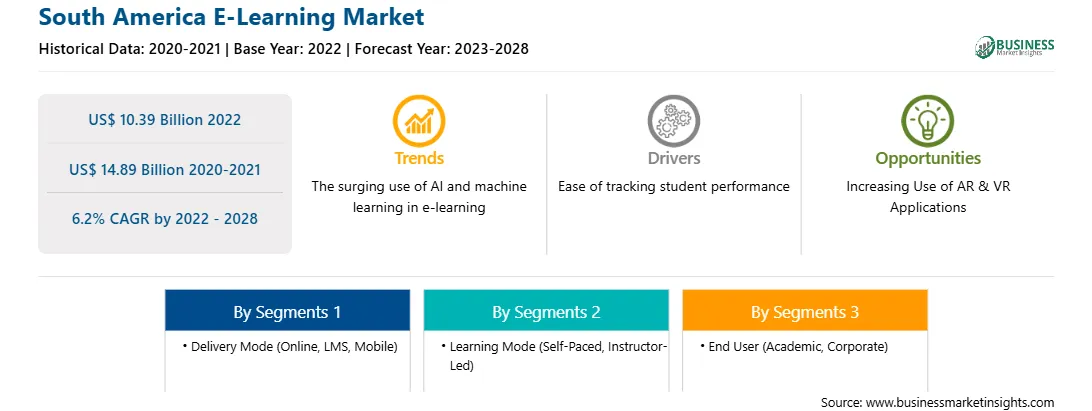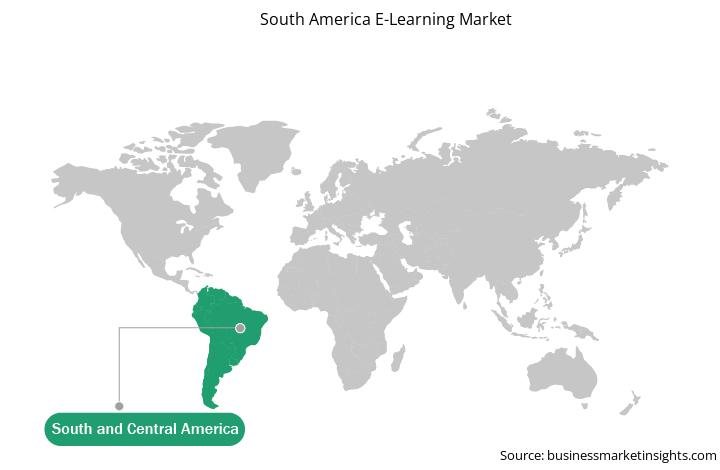In most companies, staff members of different generations work together. As an employer, bringing benefits to an organization through different levels of experience, knowledge, and diversity contributed by baby boomers, gen Xers, and millennials becomes difficult. Moreover, a multi-generational workforce sometimes makes learning and development programs a little tricky due to differences in their learning styles and technological abilities. Younger team members generally prefer high-tech, independent training methods, while older staff may need more traditional and trainer-led approaches. Moreover, such diversity in terms of age and experience makes it challenging to create generic e-learning experiences for all since each generation has its unique traits and needs. Therefore, the need for designing the same e-learning courses for different generations limits adds to the overall cost of content development, thereby hampering the South America e-learning market growth.
The South America E-Learning Market is segmented into Brazil, Argentina, and the Rest of South America. South America has witnessed a rapid surge in the number of student enrolments in higher education over the last decade; however, the uptake of digital has been limited in the region. Governments of various South American countries are focusing on better access to higher education with significant progress in participation involving high gross enrolment rates. An increase in secondary education graduation rates, an expansion in the number of higher education institutions, a rise in the number of policies such as student loans and scholarships, and high spending on education have increased student participation in various e-learning and online modes of education. This, in turn, is propelling the demand for e-learning solutions across South America.
Various South American countries such as Brazil, Colombia, and Chile are steadily adopting e-learning solutions to meet the demand for high-quality education. Governments in countries such as Brazil and Argentina are providing various incentives to e-learning solution providers to boost citizens' employability skills through new digital learning mechanisms. However, the lack of compliance of learning tools with specific industry standards hampers the growth of the South America E-Learning Market. Several organizations and educational institutions are expected to use e-learning platforms in the coming years, which is likely to support the market growth during the forecast period.

Strategic insights for the South America E-Learning provides data-driven analysis of the industry landscape, including current trends, key players, and regional nuances. These insights offer actionable recommendations, enabling readers to differentiate themselves from competitors by identifying untapped segments or developing unique value propositions. Leveraging data analytics, these insights help industry players anticipate the market shifts, whether investors, manufacturers, or other stakeholders. A future-oriented perspective is essential, helping stakeholders anticipate market shifts and position themselves for long-term success in this dynamic region. Ultimately, effective strategic insights empower readers to make informed decisions that drive profitability and achieve their business objectives within the market.

| Report Attribute | Details |
|---|---|
| Market size in 2022 | US$ 10.39 Billion |
| Market Size by 2028 | US$ 14.89 Billion |
| Global CAGR (2022 - 2028) | 6.2% |
| Historical Data | 2020-2021 |
| Forecast period | 2023-2028 |
| Segments Covered |
By Delivery Mode
|
| Regions and Countries Covered | South and Central America
|
| Market leaders and key company profiles |
The geographic scope of the South America E-Learning refers to the specific areas in which a business operates and competes. Understanding local distinctions, such as diverse consumer preferences (e.g., demand for specific plug types or battery backup durations), varying economic conditions, and regulatory environments, is crucial for tailoring strategies to specific markets. Businesses can expand their reach by identifying underserved areas or adapting their offerings to meet local demands. A clear market focus allows for more effective resource allocation, targeted marketing campaigns, and better positioning against local competitors, ultimately driving growth in those targeted areas.

The South America e-learning market is segmented into delivery mode, learning mode, end user, and country.
Based on delivery mode, the South America e-learning market is segmented into online, LMS, mobile, and others. The online segment held the largest South America e-learning market share in 2022.
Based on learning mode, the South America e-learning market is segmented into self-paced and instructor-led. The instructor-led segment held the larger South America e-learning market share in 2022.
Based on end user, the South America e-learning market is segmented into academic and corporate. The academic segment held the larger South America e-learning market share in 2022. Moreover, academic segment is fragmented into K-12 and higher institutions.
Based on country, the South America e-learning market is segmented into Brazil, Argentina, and the Rest of South America. Brazil dominated the South America e-learning market share in 2022.
Adobe Inc; Cisco Systems Inc; Citrix Systems Inc; Cornerstone OnDemand Inc; and SAP SE are the leading companies operating in the South America e-learning market.
The South America E-Learning Market is valued at US$ 10.39 Billion in 2022, it is projected to reach US$ 14.89 Billion by 2028.
As per our report South America E-Learning Market, the market size is valued at US$ 10.39 Billion in 2022, projecting it to reach US$ 14.89 Billion by 2028. This translates to a CAGR of approximately 6.2% during the forecast period.
The South America E-Learning Market report typically cover these key segments-
The historic period, base year, and forecast period can vary slightly depending on the specific market research report. However, for the South America E-Learning Market report:
The South America E-Learning Market is populated by several key players, each contributing to its growth and innovation. Some of the major players include:
The South America E-Learning Market report is valuable for diverse stakeholders, including:
Essentially, anyone involved in or considering involvement in the South America E-Learning Market value chain can benefit from the information contained in a comprehensive market report.